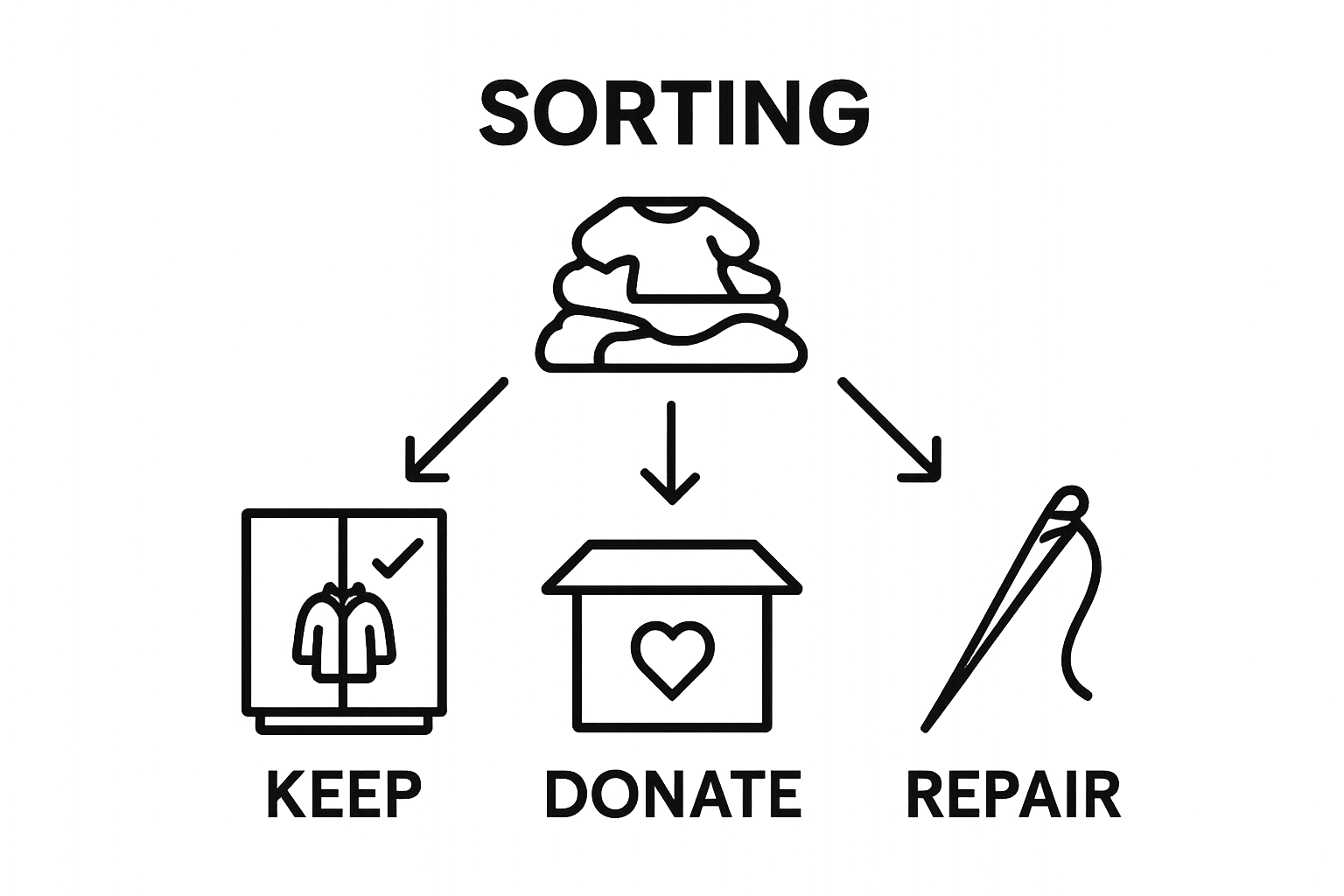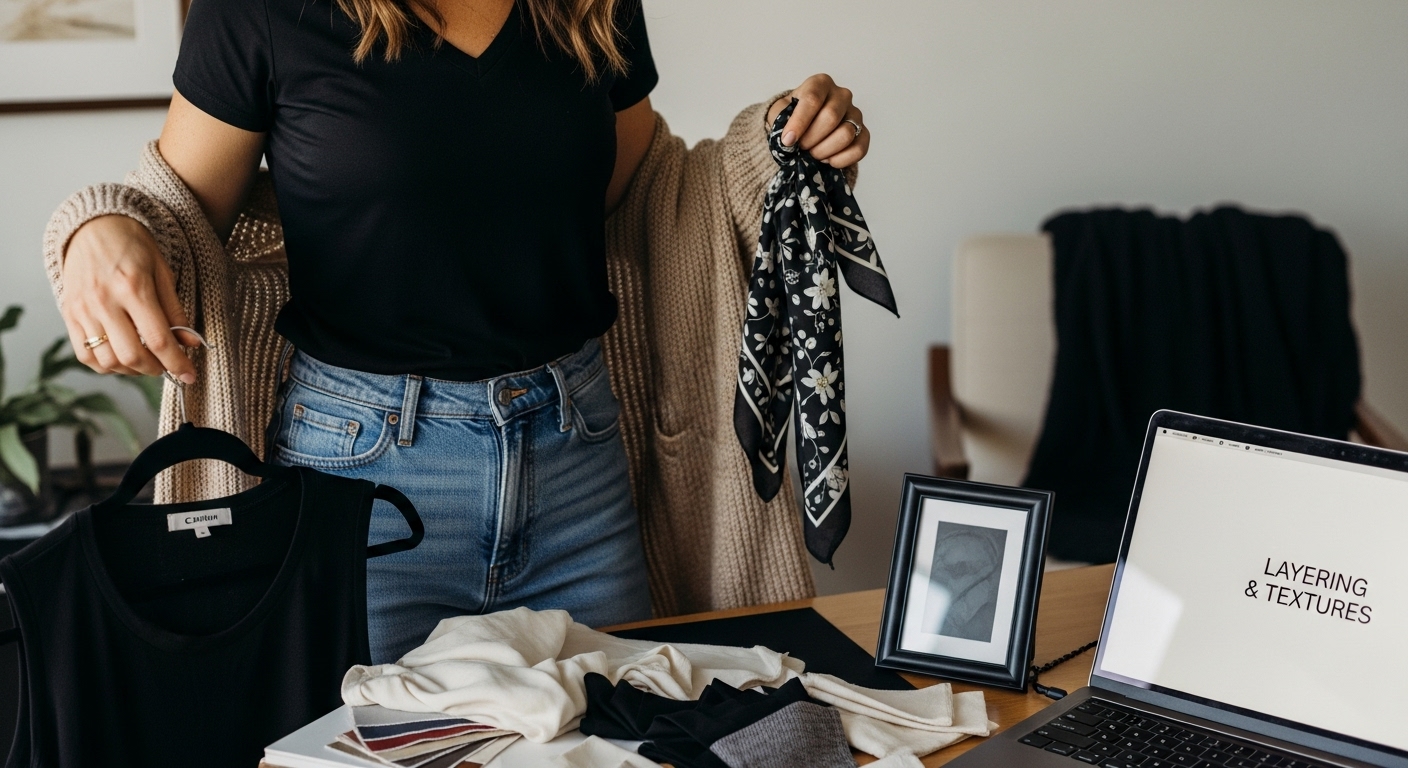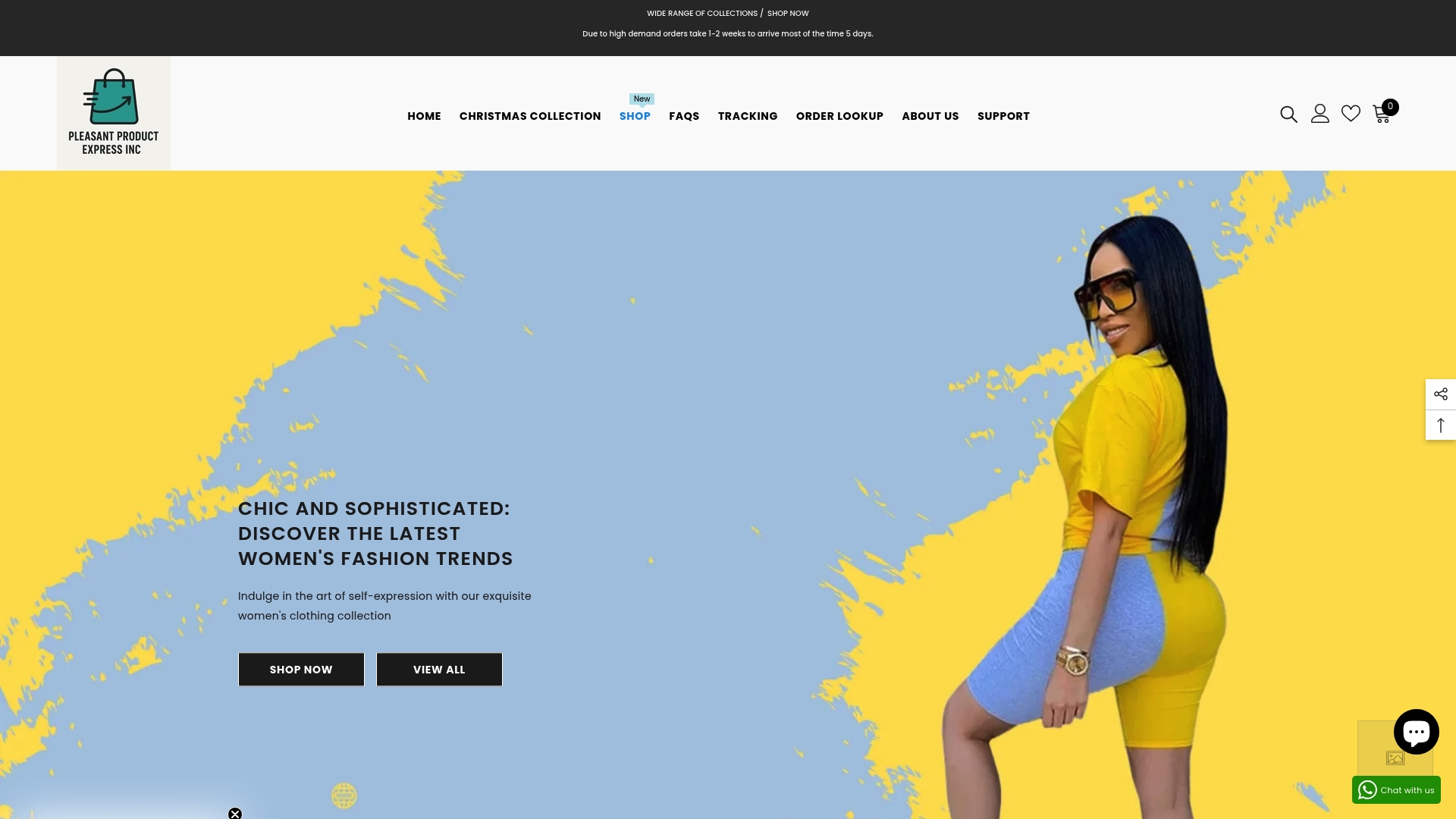How to Style Women’s Outfits: A Step-by-Step Guide
Upgrading your everyday outfits does not have to mean splurging on an entirely new closet. Most people never realize that over 60 percent of wardrobe items go unworn each year. Surprising, right? It turns out that building real style is less about chasing trends and more about mastering a few simple steps that anyone can do with what they already own.
Table of Contents
- Step 1: Assess Your Wardrobe Essentials
- Step 2: Define Your Personal Style
- Step 3: Mix and Match Outfits Creatively
- Step 4: Add Accessories for Finishing Touches
- Step 5: Experiment with Layers and Textures
- Step 6: Review and Adjust Your Outfits
Quick Summary
| Key Point | Explanation |
|---|---|
| 1. Assess Your Wardrobe Essentials | Evaluate clothing items for fit, color, and condition. Use a keep, donate, and repair system to curate your wardrobe. |
| 2. Define Your Personal Style | Develop a style that reflects your personality through visual inspiration and practical consideration of your lifestyle needs. |
| 3. Mix and Match Outfits Creatively | Combine colors and textures innovatively while balancing proportions; layer clothing to create dynamic looks. |
| 4. Add Accessories for Finishing Touches | Select accessories that enhance outfits, considering both aesthetics and functionality for personal flair. |
| 5. Review and Adjust Your Outfits | Critically assess outfits through photography; make practical adjustments for comfort and visual harmony before wearing. |
Step 1: Assess Your Wardrobe Essentials
Building a stylish wardrobe begins with a strategic assessment of your current clothing collection. This foundational step helps you understand what you already own, identify gaps in your wardrobe, and create a clear vision for your personal style. Start by clearing out a dedicated space where you can spread out all your clothing items and examine them with a critical eye.
Carefully remove every piece of clothing from your closet, drawers, and storage spaces. As you pull each item, ask yourself key evaluation questions: Does this piece fit me perfectly right now? Are the colors still vibrant? Is the fabric in good condition? Does the item make me feel confident and comfortable? This honest assessment will help you determine which pieces truly deserve a place in your refined wardrobe.
Sort your clothing into three distinct categories: keep, donate, and repair.
 The “keep” pile should include high-quality, well-fitting items that align with your current lifestyle and personal aesthetic. Timeless pieces like a crisp white shirt, well-fitted dark wash jeans, and a classic blazer are wardrobe foundations that offer versatility and longevity. For items in the “repair” category, be realistic about whether you will actually take the time to mend them or if it’s more practical to replace them.
The “keep” pile should include high-quality, well-fitting items that align with your current lifestyle and personal aesthetic. Timeless pieces like a crisp white shirt, well-fitted dark wash jeans, and a classic blazer are wardrobe foundations that offer versatility and longevity. For items in the “repair” category, be realistic about whether you will actually take the time to mend them or if it’s more practical to replace them.
The donation pile presents an opportunity to refresh your wardrobe while potentially helping others. Consider donating gently used clothing to local shelters, charitable organizations, or consignment shops. This not only clears physical space but also allows your pre-loved items to find new life with someone who will appreciate them.
To make this process more systematic, read our guide on mastering the outfit matching process which provides additional insights into creating a cohesive wardrobe. By the end of this assessment, you should have a curated collection of clothing that truly represents your style, fits well, and makes you feel confident in any setting.
Here is a checklist you can use during your wardrobe assessment to ensure you keep, donate, or repair each item effectively.
| Step | Action | What to Look For | Outcome |
|---|---|---|---|
| 1 | Remove all clothing | Collect every piece from closet, drawers, storage | Full wardrobe visible |
| 2 | Evaluate fit | Does it fit perfectly right now? | Keep if yes |
| 3 | Check color & condition | Are colors vibrant and fabric in good shape? | Keep or move to repair |
| 4 | Assess confidence & comfort | Does it make you feel confident and comfortable? | Keep or donate |
| 5 | Sort into piles | Keep, Donate, Repair | Every item assigned |
| 6 | Decide on repair items | Will you realistically mend or replace? | Move to repair or replace |
| 7 | Donate gently used clothes | Give to shelters, charities, or consignment | Donation pile gone |
Step 2: Define Your Personal Style
Defining your personal style is about creating a visual language that authentically represents your personality, lifestyle, and unique aesthetic preferences. This critical step transforms your wardrobe from a random collection of clothes into a curated expression of who you are. The journey begins with deep self-reflection and intentional exploration of your fashion identity.
Start by gathering visual inspiration from multiple sources. Create a digital or physical mood board that captures styles, colors, and silhouettes that resonate with you. Browse fashion magazines, social media platforms, and style blogs, but remember that true personal style goes beyond simply copying trends. Look for recurring themes in the images that spark joy and make you feel confident. Pay attention to the details that consistently attract your eye - whether it’s a specific color palette, a particular cut of clothing, or a unique accessory combination.
Consider the practical aspects of your lifestyle when defining your style. A corporate professional will have different style needs compared to a creative freelancer or a stay-at-home parent. Your personal style should not only look good but also function seamlessly within your daily activities. Experiment with different combinations of clothing that balance comfort, practicality, and personal expression. Explore our ultimate guide to mixing fashion styles for advanced techniques in creating versatile looks that reflect your unique personality.
To truly solidify your personal style, conduct a series of intentional experiments. Try on different clothing combinations, take photographs, and critically assess what makes you feel most authentic. Look beyond surface-level trends and focus on pieces that enhance your body shape, complement your skin tone, and align with your personal narrative. Your goal is to develop a wardrobe that feels like a natural extension of yourself - one that boosts confidence and allows your inner personality to shine through every carefully selected outfit.
Step 3: Mix and Match Outfits Creatively
Creative outfit mixing transforms your wardrobe from a collection of individual pieces into a dynamic, personalized style statement. This step is about breaking traditional fashion rules and developing the confidence to experiment with unexpected combinations that reflect your unique personality. Think of your clothing as a visual vocabulary where each piece can tell a different part of your story.
Color and texture become your primary tools for creative styling. Start by understanding basic color theory - complementary colors can create striking contrasts, while monochromatic outfits offer sophisticated elegance. Don’t be afraid to pair unexpected textures like a soft silk blouse with structured denim or a chunky knit sweater with sleek leather pants. The key is maintaining a balanced visual weight that prevents any single element from overwhelming your overall look.
Layering presents another powerful strategy for creative outfit construction. Begin with foundational pieces like well-fitted basics and gradually add dimension through strategic layering. A tailored blazer can instantly elevate a simple t-shirt and jeans combination, while a lightweight cardigan can transform a summer dress into a versatile transitional outfit. Pay attention to proportions - if you’re wearing a loose top, balance it with more fitted bottoms to maintain a polished silhouette.
Check out our ultimate guide to affordable fashion for additional insights into budget-friendly styling techniques. Developing a mix-and-match approach requires practice and a willingness to step outside your comfort zone.
Take photographs of your outfit combinations to track your progress and identify styling techniques that make you feel most confident. Remember that personal style is an ongoing journey of self-discovery, and each creative outfit combination is an opportunity to express your evolving aesthetic vision.
Step 4: Add Accessories for Finishing Touches
Accessories are the secret language of personal style, transforming ordinary outfits into extraordinary expressions of individual creativity. These finishing touches are more than mere decorative elements - they are powerful tools that can elevate, balance, and personalize your entire ensemble. Think of accessories as the punctuation marks in your fashion story, adding emphasis, nuance, and personal flair to your carefully curated look.
Jewelry serves as a cornerstone of accessory styling, offering immediate opportunities for self-expression. Select pieces that complement both your outfit and personal aesthetic. A delicate gold necklace can add sophistication to a simple white shirt, while statement earrings can inject vibrant energy into a monochromatic outfit. Consider the visual balance - if you’re wearing a busy pattern, opt for more minimalist jewelry that won’t compete for attention. Metals can be mixed thoughtfully; don’t feel constrained by traditional rules that mandate wearing only gold or silver.
Bags, scarves, and belts provide additional layers of styling potential. A structured handbag can instantly make a casual outfit look more polished, while a silk scarf can introduce color and texture to a neutral ensemble. Belts are particularly versatile, capable of defining waistlines, breaking up visual monotony, and adding architectural interest to your outfit. When selecting accessories, consider both form and function. A beautiful clutch that can’t hold your essentials or a stunning belt that’s uncomfortably tight defeats the purpose of accessorizing.
Explore our ultimate guide to affordable fashion for budget-friendly accessory tips that can transform your wardrobe. Remember that confidence is the most important accessory - choose pieces that make you feel authentically yourself, and your personal style will shine through effortlessly.
Step 5: Experiment with Layers and Textures
Layering and texture exploration transform your outfit from a simple ensemble into a nuanced, visually compelling narrative. This step is about understanding how different fabrics, weights, and materials can interact to create depth, visual interest, and functional versatility in your wardrobe. Think of layering as an art form where each piece serves a purpose beyond mere coverage.
Start by building a foundation of complementary textures that create visual harmony without overwhelming your silhouette. Begin with lightweight, breathable base layers like a soft cotton tank or a thin merino wool shirt. These foundational pieces should feel comfortable against your skin and provide a neutral canvas for more complex layering. Consider the interplay between smooth and rough textures - a silk blouse tucked into a chunky knit sweater creates an intriguing contrast that adds sophistication to your look. Experiment with different fabric weights and materials, mixing structured pieces like a tailored blazer with more fluid elements like a chiffon scarf or a lightweight cardigan.
Understanding proportion is crucial when mastering the art of layering.
 Balance is key - if you’re wearing a voluminous top, pair it with more fitted bottoms to maintain a streamlined silhouette. Cropped jackets work wonderfully over longer shirts or dresses, creating interesting visual lines that draw the eye. Don’t be afraid to play with unexpected combinations - a leather jacket over a delicate floral dress can create a perfect balance between soft and edgy aesthetics. Pay attention to color coordination, ensuring that your layers complement rather than compete with each other.
Balance is key - if you’re wearing a voluminous top, pair it with more fitted bottoms to maintain a streamlined silhouette. Cropped jackets work wonderfully over longer shirts or dresses, creating interesting visual lines that draw the eye. Don’t be afraid to play with unexpected combinations - a leather jacket over a delicate floral dress can create a perfect balance between soft and edgy aesthetics. Pay attention to color coordination, ensuring that your layers complement rather than compete with each other.
Explore our ultimate guide to mixing fashion styles for additional insights into creating cohesive layered looks. Remember that confidence is the ultimate accessory - trust your instincts and enjoy the process of discovering unique combinations that make you feel authentically stylish.
Step 6: Review and Adjust Your Outfits
The final step in crafting a stunning outfit is a critical process of review and refinement. This stage transforms good outfits into exceptional ones by applying a discerning eye and making precise adjustments that elevate your overall look. Think of this as the final polish that distinguishes a carefully curated ensemble from a hastily thrown-together outfit.
Photographic review provides an objective perspective on your outfit’s overall composition and fit. Set up a full-length mirror or use your smartphone to capture multiple angles of your look. Pay close attention to how different elements interact - does the jacket sit correctly on your shoulders? Are the proportions balanced? Examine the outfit as if you were seeing it on someone else, which helps eliminate personal biases and allows for more critical assessment. Look for potential adjustments like slightly rolling up sleeves, repositioning a belt, or changing one accessory to create better visual harmony.
Comfort and functionality are equally important during your final outfit review. Move around and simulate your daily activities to ensure the outfit allows for comfortable movement and meets the practical demands of your day. Sit down, walk around, and test how different pieces interact. Check for potential wardrobe malfunctions or areas of discomfort - a slightly too-tight waistband or a shirt that rides up can quickly transform a great outfit into an uncomfortable experience. Consider the specific environment you’ll be wearing the outfit in, whether it’s a professional setting, a casual outing, or a special event.
Check out our ultimate guide to mixing fashion styles for additional insights into perfecting your outfit combinations. Remember that personal style is an ongoing journey of self-discovery and refinement. Trust your instincts, be willing to make small adjustments, and most importantly, wear your outfit with confidence.
Unlock Your Personal Style With Pleasant Product Express
Struggling to define your look or frustrated by mismatched outfits? This step-by-step guide uncovered common fashion challenges like identifying wardrobe essentials, mastering outfit combinations, and creating a style that feels truly yours. As you work on building confidence with layering and adding those perfect final touches, the right pieces—and a smooth shopping experience—make all the difference.

Why wait to put your new skills into action? At Pleasant Product Express INC, you can find quality, affordable women’s clothing and accessories that match your style goals. Confidently apply fresh ideas from the ultimate guide to affordable fashion or discover added inspiration in the ultimate guide to mixing fashion styles. Elevate your look today and enjoy a pleasant shopping experience designed to help you express your unique style right now.
Frequently Asked Questions
What are the essential steps for assessing my wardrobe?
Start by clearing out all your clothing items and evaluating each piece based on fit, condition, and whether it aligns with your personal style. Sort items into three categories: keep, donate, and repair.
How can I define my personal style effectively?
Gather visual inspiration through mood boards and identify recurring themes that resonate with you. Consider your lifestyle needs and experiment with different clothing combinations to discover what feels most authentic.
What are some creative ways to mix and match outfits?
Utilize color theory and texture pairing to enhance your outfit combinations. Layering is also critical; start with well-fitted basics and add dimension with outer layers while ensuring balanced proportions.
How can I choose the right accessories to finish my outfit?
Select accessories that complement your outfit while adding personality. Consider both aesthetic appeal and functional use, ensuring that each piece enhances rather than distracts from your overall look.
Recommended
- Master the Outfit Matching Process for Effortless Style – Pleasant Product Express Inc
- Ultimate Guide to Mixing Fashion Styles for Unique Looks – Pleasant Product Express Inc
- The Ultimate Guide to Affordable Fashion for 2025 – Pleasant Product Express Inc
- 8 Essential Types of Women’s Shoes You Should Know – Pleasant Product Express Inc







